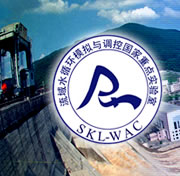《Hydrological Processes》杂志刊登“在湿润粒状坡的局部由于蒸发形成的细观力学侵蚀模型”
作者:F. Gabrieli, P. Lambert, S. Cola, F. Calvetti
刊物:Hydrological Processes ,2012年5月,36卷7期,918–943页
关键词:离散元;侵蚀;蒸发;粒状坡;不完全饱和; 毛细管桥
摘要:粒状坡中含有少量的水能够增加坡的整体稳定性,并能够使坡维持大坡角,这与观测到的事实相符。但是蒸发会改变土壤中水的含量,尤其是在浅水层,从而导致土壤强度降低,土壤侵蚀发生。本研究提出了一些数值模拟试验,用于模拟小坡度的物理模型,这些物理模型是由处于摆动状态的单一尺寸的小玻璃球组成的。本文在简要回顾了两个不同领域所形成的描述毛细管桥的不同理论及其粒间作用力的影响之后,
用最小能量原理处理离散元模型(DEM)。在不同的含水量和约束应力作用下,进行了一系列的三轴试验,结果表明:随着含水量的降低,剪切强度增加。此外,从物理模型中进行的观测可知,DEM中也包括蒸发速率与水深和空气-水界面的关系。最后,改进的DEM 成功的运用在物理模型中土壤侵蚀过程的模拟上:DEM很好的捕获了岩屑坡剖面构造,以及粒状坡典型的长期发展过程。数值试验中对土体位移和吸力分布的监测也使得能够对土壤侵蚀机制进行评价:例如,不论是在实验型试验还是数值型试验,在表层侵蚀的初始阶段后,总能观察到在坡角处发生刚性位移。
Micromechanical modelling of erosion due to evaporation in a partially wet granular slope
Authors: F. Gabrieli, P. Lambert, S. Cola, F. Calvetti
Journal: Hydrological Processes, Volume 36, Issue 7, pages 918–943, May 2012
Keywords: discrete element; erosion; evaporation; granular slope; partial saturation; capillary bridge
Abstract:Small quantities of water in a granular slope increase the overall stability and justify the large slope angle which is sometime observable in nature. However, the evaporation usually changes the water content of soil, especially in very shallow layers, leading to a soil strength reduction and the trigger of erosion processes. This work presents some numerical tests simulating a small slope physical model constituted of monosized glass ballotini in a pendular state. After a brief review of the different theories describing the capillary bridge which forms between two spheres and its effects on inter-particle forces, this paper deals with the implementation of the minimum energy approach within a discrete element model (DEM). Some numerical triaxial tests with different water contents and confinement stresses were performed: the analyses permitted to emphasize the shear strength increase occurring at low water content. Moreover, moving from the observations performed in the physical model, a law relating the evaporation rate with depth and air–water interface was also included in the DEM. Finally, the improved DEM was successfully adopted in the simulation of the erosion process occurring in the physical model: it very well captures the formation of a talus slope profile, typical of the long-term evolution of granular slopes. The monitoring of soil displacements and suction distribution during the numerical test also allows for the evaluation of erosion mechanisms: for instance, both in experimental and numerical tests, it was observed a rigid displacement at the slope toe after the initial phase of shallow erosion.
原文链接:http://onlinelibrary.wiley.com/doi/10.1002/nag.1038/abstract
翻译:张大茹;审核:尚毅梓

